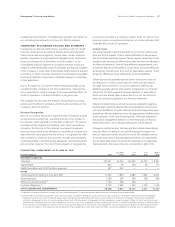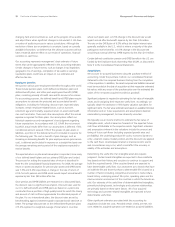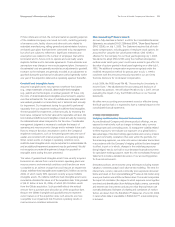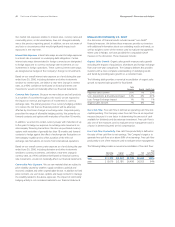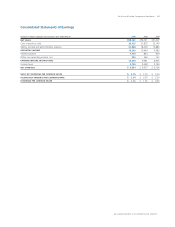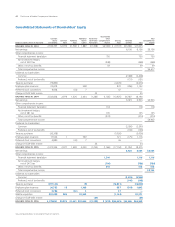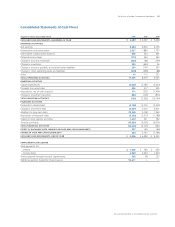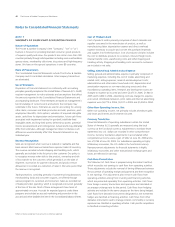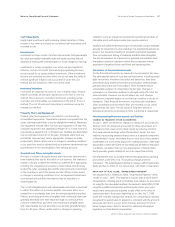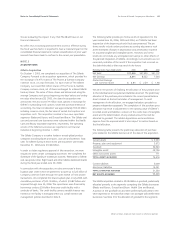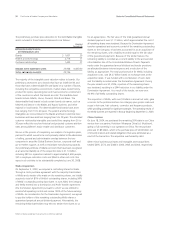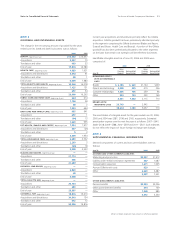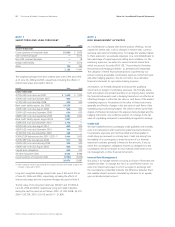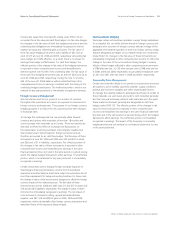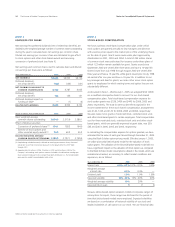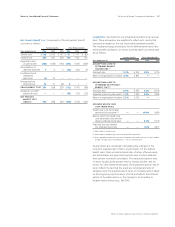Proctor and Gamble 2006 Annual Report Download - page 49
Download and view the complete annual report
Please find page 49 of the 2006 Proctor and Gamble annual report below. You can navigate through the pages in the report by either clicking on the pages listed below, or by using the keyword search tool below to find specific information within the annual report.Millions of dollars except per share amounts or otherwise specified.
Notes to Consolidated Financial Statements The Procter &Gamble Company and Subsidiaries 47
Cash Equivalents
Highly liquid investments with remaining stated maturities of three
months or less when purchased are considered cash equivalents and
recorded at cost.
Investments
Investment securities consist of auction rate securities that approximate
fair value and readily-marketable debt and equity securities that are
classified as trading with unrealized gains or losses charged to earnings.
Investments in certain companies over which we exert significant
influence, but do not control the financial and operating decisions,
are accounted for as equity method investments. Other investments
that are not controlled and over which we do not have the ability to
exercise significant influence are accounted for under the cost
method and are included in other noncurrent assets.
Inventory Valuation
Inventories are valued at the lower of cost or market value. Product-
related inventories are primarily maintained on the first-in, first-out
method. Minor amounts of product inventories, including certain
cosmetics and commodities, are maintained on the last-in, first-out
method. The cost of spare part inventories is maintained using the
average cost method.
Property, Plant and Equipment
Property, plant and equipment is recorded at cost reduced by
accumulated depreciation. Depreciation expense is recognized over the
assets‘ estimated useful lives using the straight-line method. Machinery
and equipment includes office furniture and equipment (15-year life),
computer equipment and capitalized software (3- to 5-year lives) and
manufacturing equipment (3- to 20-year lives). Buildings are depreciated
over an estimated useful life of 40 years. Estimated useful lives are
periodically reviewed and, where appropriate, changes are made
prospectively. Where certain events or changes in operating conditions
occur, asset lives may be adjusted and an impairment assessment may
be performed on the recoverability of the carrying amounts.
Goodwill and Other Intangible Assets
We have a number of acquired brands that have been determined to
have indefinite lives due to the nature of our business. We evaluate a
number of factors to determine whether an indefinite life is appropriate,
including the competitive environment, market share, brand history,
product life cycles, operating plan and the macroeconomic environment
of the countries in which the brands are sold. Where certain events
or changes in operating conditions occur, an impairment assessment
is performed and indefinite-lived brands may be adjusted to a
determinable life.
The cost of intangible assets with determinable useful lives is amortized
to reflect the pattern of economic benefits consumed, either on a
straight-line or accelerated basis over the estimated periods benefited.
Patents, technology and other intangibles with contractual terms are
generally amortized over their respective legal or contractual lives.
Customer relationships and other noncontractual intangible assets
with determinable lives are amortized over periods generally ranging
from 5 to 40 years. Where certain events or changes in operating
conditions occur, an impairment assessment is performed and lives of
intangible assets with determinable lives may be adjusted.
Goodwill and indefinite-lived brands are not amortized, but are evaluated
annually for impairment or when indicators of a potential impairment are
present. Our impairment testing of goodwill is performed separately
from our impairment testing of individual indefinite-lived intangibles.
The annual evaluation for impairment of goodwill and indefinite-lived
intangibles is based on valuation models that incorporate internal
projections of expected future cash flows and operating plans.
Fair Values of Financial Instruments
Certain financial instruments are required to be recorded at fair value.
The estimated fair values of such financial instruments, including certain
debt instruments, investment securities and derivatives, have been
determined using market information and valuation methodologies,
primarily discounted cash flow analysis. These estimates require
considerable judgment in interpreting market data. Changes in
assumptions or estimation methods could significantly affect the fair
value estimates. However, we do not believe any such changes
would have a material impact on our financial condition or results of
operations. Other financial instruments, including cash equivalents,
other investments and short-term debt, are recorded at cost, which
approximates fair value. The fair values of long-term debt and
derivative instruments are disclosed in Note 5 and Note 6, respectively.
New Accounting Pronouncements and Policies
CHANGE IN TREASURY STOCK ACCOUNTING
On July 1, 2005, we elected to change our method of accounting for
treasury stock. We previously accounted for share repurchases as if
the treasury stock were constructively retired by reducing common
stock and retained earnings within Shareholders’ Equity. Our new
method of accounting presents treasury stock as a separate component
of Shareholders’ Equity. We believe that our new accounting method
is preferable as it more closely depicts the underlying intent of the share
repurchases in which the shares are not retired and are held for reissuance.
In addition, we believe that our new presentation of Shareholders’
Equity provides greater visibility of our share repurchase activity.
We reflected this new accounting method retrospectively by adjusting
prior periods under SFAS 154, “Accounting Changes and Error
Corrections.” This reclassification is limited to changes within Shareholders’
Equity and has no effect on our net earnings, cash flows or total assets.
ADOPTION OF SFAS 123(R), “SHARE-BASED PAYMENT”
We adopted SFAS 123(Revised 2004), “Share-Based Payment” (SFAS
123(R)) on July 1, 2005. This Statement requires that all stock-based
compensation, including grants of employee stock options, be accounted
for using the fair value-based method. We elected to adopt SFAS 123(R)
using the modified retrospective method under which prior years’
results were retrospectively adjusted to give effect to the value of
options granted in fiscal years beginning on or after July 1, 1995.
Under the modified retrospective method, the compensation expense
recognized for periods prior to adoption is consistent with the amounts
previously reported in our pro forma footnote disclosure for stock-
based compensation. Refer to Note 8 for additional information
regarding our stock-based compensation.


